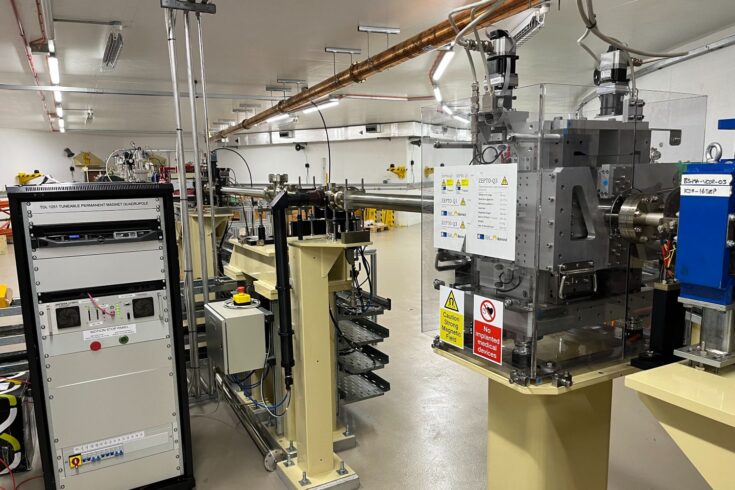Particle accelerators are important in many aspects of physics. They help us uncover a hidden world much smaller than our eyes can see, they teach us about the origins of the universe and why the world is the way it is. Despite this, their high energy usage makes them expensive to run, due in no small part to their electromagnets.
Experts at the Science and Technology Facilities Council’s (STFC) Daresbury Laboratory have been developing a sustainable alternative to these magnets. The Zero Power Tuneable Optics (ZEPTO) magnet is a novel way for accelerators to reduce both running costs and carbon footprint. The magnet is now being tested at Diamond Light Source.
How do magnets in a particle accelerator work?
The most common way for a particle accelerator to control the particle beam is to use electromagnets. These work by flowing an electrical current, usually several hundred amps (UK household plug will run between 3 to 13 amps), through a coil of copper wire wrapped around specially shaped steel.
As the current flows through the wire, it generates a magnetic field, complying with Faraday’s law of induction (one of the many laws of physics), which is then conducted by the steel towards the beam. The current can then be increased or decreased to influence the magnetic field strength of the electromagnet, depending on the experiment’s requirements or what happens to the beam during the experiment.
As the current through the wire has to be constantly flowing for the magnetic field to be present it can create quite a large energy bill and, by extension, carbon emission during ‘on’ periods. It is predicted that 1 quadrupole magnet on Diamond is responsible for around 136kg of carbon dioxide released per year.
Saving power with ZEPTO magnets
So, how does a ZEPTO magnet avoid using so much power? Alex Bainbridge, Magnet Physicist and ASTeC Outreach Lead at STFC, explains:
In principle the physics is simple, it’s the engineering that was the big challenge.
ZEPTO uses permanent magnets for their magnetic field, a classic example of this type of magnet is the standard fridge magnet.
However, ZEPTO’s magnetics are larger and made of a special type of material known as samarium cobalt.
Permanent magnets made from this material can be made extremely strong under the right conditions when created.

A close up of the ZEPTO magnet with the Diamond Light Source beam line running through. Labels showing the north and south poles can be seen on the magnet. Credit: STFC
Now we have a magnet with a permanent magnetic field, but what if we want to change the field strength to help our accelerator beam? This is where the difficulty begins. 4 curved pieces of steel are located inside the ZEPTO magnet, which direct the field generated by the permanent magnets to create a quadrupole.
A quadrupole is a magnet with 2 north poles directly opposite each other for example at the top left and bottom right of the beam and 2 south poles opposite each other at the top right and bottom left. This makes a field which is zero in the exact centre of the 4 magnets (and therefore the centre of the beam) and increases in strength as you move out, back toward the surface of the steel.
By lowering or raising the magnets into the system the field created in the steel will be increased or decreased. That sounds easy right? Well, we have all experienced trying to pull a magnet off a fridge. Now imagine that magnet was much, much larger and much, much stronger. The force required to move the magnets away from the steel can be up to the weight of a small car!
What’s more, as soon as the magnets are moved, the force required can change in both strength and direction due to an additional loop of steel that directs the field away from the beam. So, moving the magnets has to be done carefully through the use of a motor, only requiring a few watts of power over a short period of time.
Looking toward a greener future
Alex is hopeful that the ZEPTO magnet will hail real change in accelerator science:
We are excited for our ZEPTO magnet to prove, during the test period, that it is just as effective as an electromagnet over long periods of time.
This will give a solution for particle accelerators reducing their power consumption while maintaining great performances.
This project is one step in our commitment to big science reducing its impact on the planet. STFC colleagues also hosted our first sustainable accelerator workshop in 2022, where facilities from across the world shared their own best practice and discussed potential actions for the future.
Further information
Find out more about STFC’s role in creation and development of ZEPTO magnets.
For regular updates from Daresbury Laboratory, follow the lab on Twitter and Facebook.



